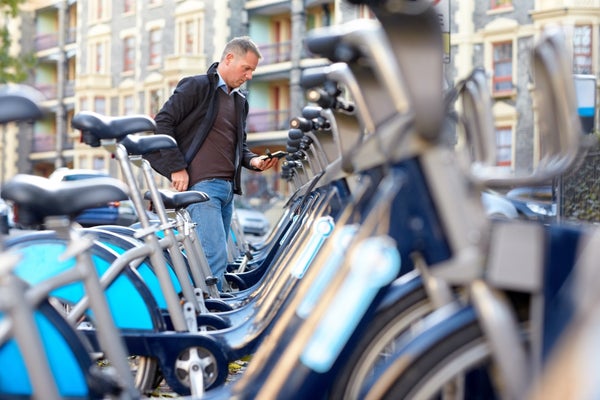This article was published in Scientific American’s former blog network and reflects the views of the author, not necessarily those of Scientific American
Cities across the country, including New York, Washington, Boston and San Francisco have launched bike-share programs as sustainable transportation alternatives that ease traffic congestion, improve public health, and cut carbon emissions. Cyclists in those cities, meanwhile, have embraced bike-sharing to make their commutes faster, cheaper, and more fun. Last year, U.S. bike-share riders completed nearly 46 million trips—more than twice as many trips from the previous year.
Yet despite these programs’ advantages and popularity, significant operational challenges remain. Take, for instance, the distribution of bikes. Because of commuting patterns, residential neighborhoods face shortages of bicycles in the morning rush, while business districts have a dearth of bikes in the evening. What’s more, parking docks can be full at certain hours, making it difficult for riders to return the bikes once they’ve reached their destinations.
Remedying this problem is not easy. Bike-share systems often race against riders to remove bikes from fully occupied stations and refill docks in stations where they are needed—a juggle known as rebalancing—during peak commuting hours. Many systems rebalance their bike supply using fleets of box trucks that reallocate dozens of bikes at a given time. This is a costly, time-consuming endeavor that enlarges the systems’ carbon footprint. Thus, it is crucial that rebalancing be as efficient as possible.
On supporting science journalism
If you're enjoying this article, consider supporting our award-winning journalism by subscribing. By purchasing a subscription you are helping to ensure the future of impactful stories about the discoveries and ideas shaping our world today.
Despite the fact that general demand patterns are predictable in aggregate, bike-share systems are complex networks and operational decisions involve plenty of subtleties. Take, for example, the decisions around moving bikes to New York City’s East Village. Being a residential neighborhood, there is great demand every morning from commuters renting bikes on their way to work; moving additional bikes there intuitively makes sense. Yet during the afternoon rush, when the tide of demand changes, bikes that were added in the late morning, too late to be used by commuters, block cyclists from returning their bikes on their trips home. Identifying the point at which no additional bikes should be moved is critical; for that, we cannot rely on our intuition but must instead take a data-driven approach.
With that in mind, my colleagues and I—David B. Shmoys and Shane G. Henderson of Cornell University; Hangil Chung, a Cornell graduate; and Eoin O'Mahony, a Cornell PhD—set out to develop sophisticated algorithms and advanced analytics to tackle the novel challenges of bike-share operations.
One area in which our methods were applied was the Bike Angels program that our industry collaborators at Motivate (now part of Lyft) run in cities across the country. As part of the program, cyclists earn points by renting or returning bikes at certain high-need stations. Initially, the program awarded points for the same pattern of stations every morning, and a different fixed pattern each afternoon. In a study, we found that these fixed patterns cause inefficiencies when returns (or rentals) are incentivized in locations where they do not actually help with rebalancing.
These inefficiencies are not only due to imperfect demand forecasts, but also to heterogeneity within individual rush hours. In other words, the system sometimes changes too fast for a constant pattern to be efficient over a full rush hour; changing the patterns based on real-time information can increase the impact of the incentives by around 15 percent.
Today, Bike Angels accounts for roughly 30 percent of bike rebalancing in New York City. It has boosted customer satisfaction which, in turn, has increased ridership. And importantly, this form of rebalancing comes with a much better carbon footprint than box trucks!
We applied analytics to solve other problems, too. For instance, we leveraged user data to identify sets of stations at which the number of parking docks was often underutilized, and also to determine which stations would benefit from additional parking capacity. This allowed operators to move docks within the system and thereby sustainably increase ridership in the system.
Another algorithm helped bike-share operators remotely identify faulty equipment. By analyzing usage information, we were able to help operators make accurate determinations about whether they need to send out crews to fix a broken bike or dock. Dealing with maintenance issues in a timely manner is another context in which analytics can have significant impact on cyclists’ experience.
To be sure, analytics and algorithms are not the panacea to every new transportation problem. They have many limitations, including incomplete information due to censored demand. That is, we only observe the realized rentals (returns) at stations at which bikes (docks) were available, not those that were blocked due to the imbalance of the system.
And yet, it is also clear that many challenges that arise with new mobility options, including e-bikes and free-floating bike-sharing systems, require data-driven solutions. As cities move towards reduced car ownership, analytics can help society pedal in the right direction.
The work described here earned Daniel Freund and his team the 2018 Daniel H. Wagner Prize for Excellence in Operations Research Practice.
